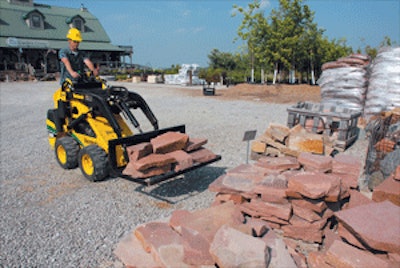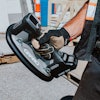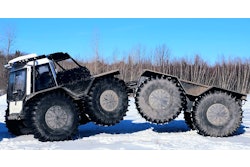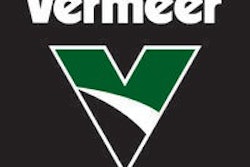
Why are compact utility loaders (CULs) so popular with rental customers? Let us count the ways. Their narrow width allows the machines to access areas that other equipment cannot. Their low ground pressure causes less damage to established turf, paving stones and sidwalks. They are easy to operate and offer a 360-degree unobstructed view to the operator. They can be easily transported on a single-axle trailer.
"CULs were specifically developed to assist contractors and homeowners looking for a machine that could reduce their dependence on hand labor and bulkier pieces of equipment," says Greg Lawrence, marketing product manager with The Toro Co. "Contractors rent them for everything from installing an irrigation system to building a retaining wall. Homeowners take advantage of the easy-to-use controls for do-it-yourself backyard projects."
The biggest plus for CULs is their versatility. As mentioned, CULs can be used for a contractor project one day, and a homeowner project the next. "Rental companies can take advantage of this versatility of the CUL and keep it rented everyday," says Jon Kuyers with Vermeer.
What?s the key to the CUL versatility? The attachments, of course.
The attachment aspect
With upwards of 70 available attachments, CULs can go way beyond earthmoving. They can trench for irrigation, drainage or electrical lines. The vibratory plow can place pipe and utility cable in the ground with minimal disturbance. Forks can move pallets of sod, stones, retaining blocks and more. Tillers prepare the ground for seeding, and augers drill holes for fence posts, trees, deck footings and more.
"I would go as far as to say a CUL isn't really designed to move vast amounts of earth," says Andy Lewis with Boxer Equipment. "One of its advantages - it's compact size - is also its greatest disadvantage. These machines are designed to provide big power in small places. CULs, in essence, are a single-drive unit, multiple-attachment approach to project solving. By providing an array of functionality via its attachments, one can easily see the cost savings over acquiring several single-purpose types of equipment."
Some CULs - like Bobcat's MT52 and MT55, which offer the Bob-Tach attachment mounting system - have the ability to share some attachments with skid steers, compact track loaders and compact excavators. This helps stretch your attachment rental inventory.
Spec'ing a CUL
Because it is so versatile and will be used in many different applications, there are several items to consider when selecting a CUL for your rental inventory. The first area to examine is your customer base. Does your base lean more toward homeowners (who, with less experience with construction machinery, might need easier-to-understand controls)? Or is it more contractor-heavy? Do your contractors work in construction or landscaping? These are all things to consider.
Once you've examined your customer base, you need to make sure the CUL has enough horsepower for the applications it will perform in. Whether the engine is diesel or gas will also come into play. Diesel engines will provide more torque for applications in difficult ground conditions. Gas engine models tend to be less expensive, says Lawrence with Toro, and more universal in rental.
It will also need enough hydraulic power to power the attachments it will operate. "You want to make sure that the equipment is going to perform the functions your customers require," says Greg Rostberg, marketing manager with Bobcat. "Many customers need to use attachments that run off of auxiliary hydraulics. Make sure the CUL has auxiliary hydraulics so customers can use all the functions of the attachments."
CULs do come in ride-on or walk-behind designs. The preference for either design depends on the operator and the applications for which the machine will be used. "If a contractor is working in confined spaces and is only using the CUL here and there, a walk-behind unit is the most efficient option for them," explains Lawrence. "However, if a contractor is using the unit all day and covering a lot of ground, a ride-on unit may best fit their needs. Toro's TX platform has the ability to self-store against the machine, allowing the operator to walk behind the CUL if necessary."
There's also the decision whether rubber tires or tracks are best for your customer base. "Sometimes, it's a geographical consideration," says Kuyers with Vermeer. "Other times it's based on application. If the unit is going to be working on hard surfaces, then tires are usually best. If it's turf and sand, then go with tracks."
Some CULs are available with trailers that not only transport the CUL, but its many attachment options. "Considered by many contractors - both construction and landscape professionals - to be virtual heavy equipment tool boxes, these integrated trailer systems allow operators to tow a single trailer with all the necessary implement to complete the job," says Lewis with BOXER.
Other considerations for selecting the right CUL include durability of the machine, supplier support and resale value. "Inevitably, the time will come when the equipment will have to be traded in or sold as the rental company makes way for newer machines," says Rostberg with Bobcat. "Consider brands that are respected in the industry and have a consistent history of providing good support and resale values."
Most popular attachments
Compact utility loaders are only as versatile as the attachments they can be outfitted with. Other than the bucket, the most popular attachments include the auger, trencher and adjustable forks. "The reason these attachments are popular is because they are so versatile in function," says Greg Lawrence with The Toro Co.
The auger is used to plant, trees, install fences, and dig footings. The trencher is used to install irrigation systems, place underground cables, and dig footings. And the adjustable forks make moving material around a site easy.
Landscape contractors often will rent a compact utility loader and a range of attachments to supplement their fleet and grow their business. They use trencher and/or vibratory plow attachments for installing pipe, trench filler attachments for covering open trenches, underground boring unit attachments for pulling pipe under driveways and sidewalks, auger attachments for installing valve boxes and digging holes for plantings, and bucket attachments for hauling materials. Other landscape contractors will use the backhoe, pallet forks and bucket attachments to build decorative ponds.
One of the most popular homeowner applications is planting trees and digging fence footings with an auger attachment. "Homeowners also like how much faster and less work it is to transport landscaping material, such as mulch or rock, from their front yard, where it was delivered, to the backyard. A compact utility loader helps eliminate the need for the old-fashioned wheelbarrow," says Lawrence.




















